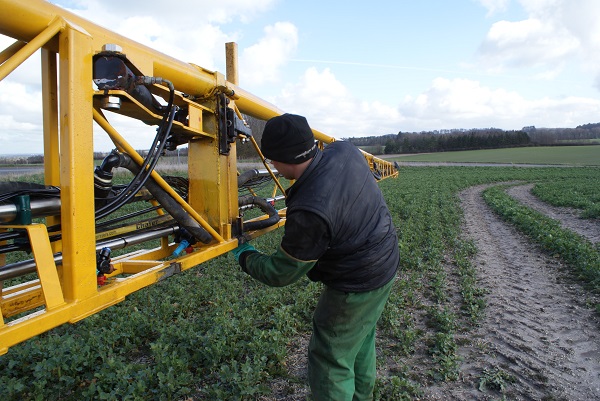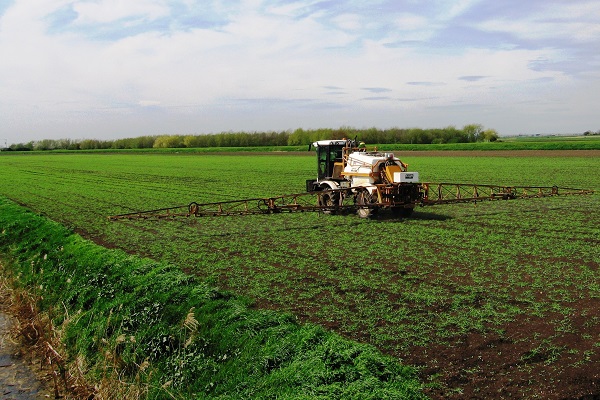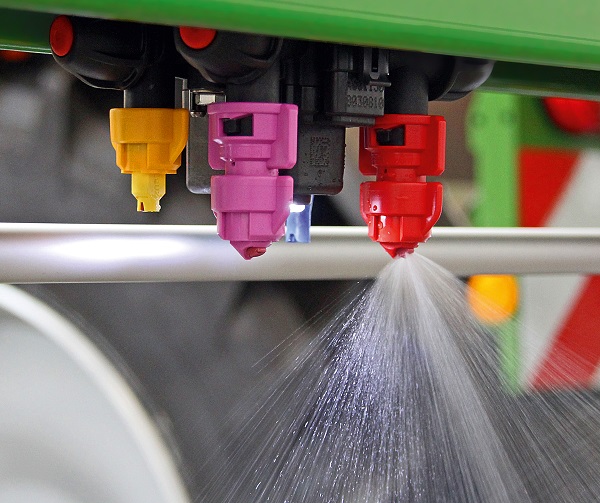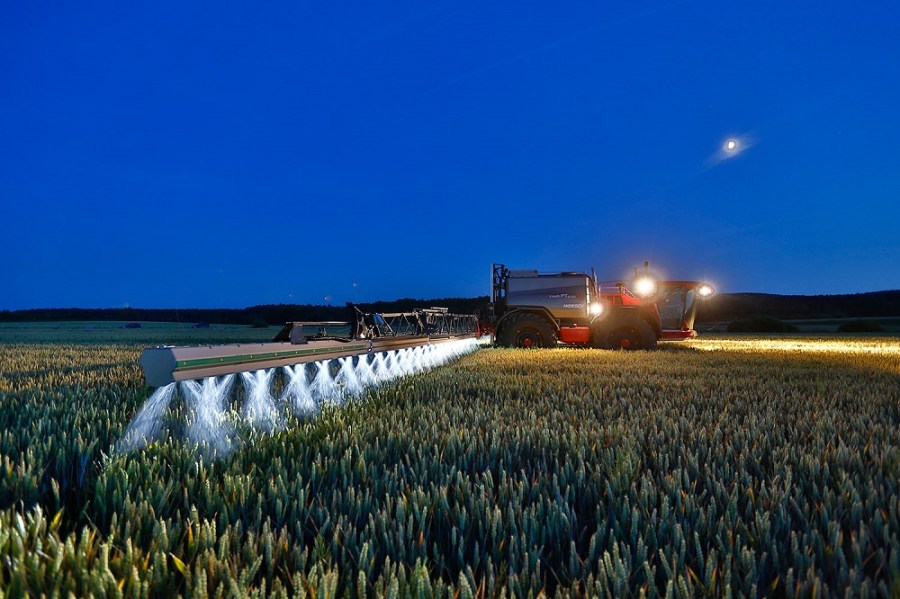The ability to switch output and classification instantly is just one of a number of benefits offered by advanced individual nozzle control systems. CPM looks at what they can do.
You can’t get the ideal application performance by using the same nozzle for everything.
By Mick Roberts
While many sprayer operators are content with the economic and environmental savings auto-section control offers, an increasing number of users are looking for ultimate accuracy, down to 50cm or less, from individual nozzle control.
These systems, once occupying the realm of specialist retro-fit equipment, are now becoming available as factory-fit options from mainstream makers such as Amazone, Horsch, Tecnoma and others. The firms say the developments are in response to an increasing

Changing nozzles manually of a wide boom can be a chore, especially if you know you need to change them back in a few minutes.
number of customer requests here and abroad.
The main drivers for change are the increasing number of application restrictions, which require operators to change droplet size or classification to meet LERAPs and buffer zone requirements, combined with wider booms. Nobody likes getting out to turn 72 holders on a 36m boom, knowing you need to change them back in a few minutes, when you could do it at the flick of a switch. Plus, operator contamination risk also needs consideration.
Droplet classification
After fitting the systems, usually for one of the reasons above, operators soon discover other benefits – the biggest being the ability to ensure the products are always being applied with the correct droplet classification.
“The best spray operators recognise that you can’t get the ideal application performance by using the same nozzle for everything,” says Dr Clare Butler Ellis of Silsoe Spray Applications Unit.
“The ability to switch nozzles automatically – particularly with wider booms – is going to make this easier and potentially improve work rates. What’s more, switching nozzles during an application – for example to use a LERAP 3-star rated nozzle for the swath nearest a watercourse, and then revert to a finer spray to get the best efficacy for the rest of the field – becomes no problem.
“Automatic nozzle selection can also help with delivering a uniform dose over the whole field. All nozzles have a working pressure range. It’s worth noting that on most modern sprayers, with flowrate control systems, pressure is not constant,” she continues.

Advanced nozzle control systems allow operators to select different nozzles, from the cab, to comply with LERAPs and other restrictions.
The output is regulated by changing the pressure. This will alter the droplet size, making sprays coarser when the machine slows and finer
as the pressure rises to match higher speeds, she explains.
“It can also change the spray pattern, so low speeds can result in very poor distribution of liquid under the boom if the pressure drops too low. So operators need to know and consider the working range and ensure they do not work outside the pressure limits.
“When it hits these limits there will be a need to change nozzles to maintain the correct dose, and that’s where the more advanced control systems have a role to play,” she explains. “And the best systems will maintain spray quality too”
One for all
Ian Griffin of Horsch UK, says up to 90% of all its sprayers are now sold with the optional 25cm nozzle spacing and the MultiSelect system.

Amazone AmaSelect provides individual electronic control of a four-way quad-nozzle carrier, which enables the jets to be switched on/off or over to another.
“This is because the narrower spacing, often using 80° nozzles, improves coverage and reduces drift. But the boom must be controlled at
a lower height than the standard 50cm in order to achieve this,” he says.
“Smaller nozzles usually create a finer spray quality, which improves coverage significantly. The trade-off is potentially more drift, so the boom needs to be run lower to compensate. To allow this to be done safely and accurately we offer Boom Control Pro, or Pro-Plus which automatically controls the boom height above the spray target,” he notes.
The optional MultiSelect system provides up to four nozzles at 50cm and two nozzles at 25cm on a single sprayline, with the ability to control each independently from the cab. Nozzles can be selected to spray individually, or in any combination, to suit the required spray quality and application rate.
“By fitting the nozzles at the 25cm spacing and running the boom lower, we can use smaller nozzles, such as 02 or 025 to apply the same rates as an 04 or 05 at the normal 50cm spacing,” he explains.
The MultiSelect system also allows for an ‘Auto Jump’ facility to be used, which automatically changes nozzles as speed increases. This is being used to provide greater efficacy by maintaining the droplet size required automatically.
“The target could be to apply 100 l/ha at 12km/h with 025 jets at 3 bar pressure. But if speed increases to 14km/h then the pressure will rise to 4 bar to achieve this, but some operators won’t even notice – because the 100 l/ha output will stay the same. With AutoSelect the system can be set to change at, say 3.25 bar, up to a 03 nozzle and a lower working pressure,” he explains.
Amazone’s individual nozzle control system, called AmaSelect, is also now an option for work at spacings of 25cm with 80° nozzles or 50cm with standard jets. The system provides individual electronic control of a four-way quad nozzle carrier, which enables the jets to be switched on/off or over to another.
This provides the benefit of being able to switch over to any of the four nozzles from the cab. But it also offers the facility to do this automatically, explains the firm’s Simon Brown.
“All the operator needs to do is input the optimum pressure range for each of the nozzles and the system switches over automatically when that limit is reached,” he says. “This also includes the option to either switch on another nozzle and use two to maintain the desired output, or change to another entirely.”
Individual nozzles can also be grouped to form ‘sections’ of any working width. This enable operators to, for example, use different, possibly low drift nozzles, on the outer parts of the boom and the standard nozzle on the sections away from the headland.
Contractors operating a wide boom with AmaSelect can also work in narrower tramlines by simply configuring the boom to whatever is required.
The pulse of change
Pulse Width Modulation (PWM) control is another system for controlling droplet size and output, while retaining the nozzle’s spray pattern.
PWM has been used for years in the USA but is still to take off in the UK. It’s ideal for operating at lower pressures and providing high drift control to higher pressure with more effective smaller droplets, all with the same single nozzle.
TeeJet offers its DynaJet Flex, which uses PWM to enable one nozzle to provide a wide range of flow for different applications. It’s designed to be easy to retro-fit, without having to change the entire spraying system. “It works with all standard spray nozzles, apart from air-induction, because they use a venturi,” he adds.
Instead of switching between separate nozzles, PWM controls the flow to a single nozzle by using a solenoid to turn it on or off at 10 times/sec (indicated as Hertz, so 10Hz). The switching is alternated between two nozzles fitted side by side to prevent skips.
“Pulsing the output of the nozzles maintains the flowrate with only a very small variation in pressure. The output in the required litres/sec is maintained by the length of time the nozzle stays open – varying this, instead of the pressure, maintains the output to match the speed. At the same time, it maintains the droplet size and does not affect the angle,” explains TeeJet’s Martin Baxter. “This also means it preserves application accuracy when, for example, applying variable rates.”
Demand for individual nozzle switching is rising and TeeJet is working on the ability to control up to 100 individual nozzles or sections. “But if you turn off just one nozzle, with a standard system you compromise the application – you need a minimum of three for effective coverage – because of the overlaps. A PWM nozzle can do this on its own,” he adds.
TeeJet is also working on ‘turn compensation’ using PWM to regulate the nozzles on the inner and outer sections of wide booms. This will maintain the proper application rate and coverage by compensating for the difference in speed of the outer edge, which will be moving much faster than nozzles closer to the vehicle while turning.
Essex farmer switches to higher accuracy
When James Faulkner upgraded to an Amazone Pantera 4502 self-propelled sprayer with 40m wide booms, he specified the AmaSelect option because he felt it would make it easier to switch between applying liquid fertiliser and pesticides. But he’s since discovered many more benefits.
James Faulkner manages R Davidson and Son’s farms at Peldon, Colchester, Essex. This is right on the east coast and the 1500ha of arable land is generally quite heavy, but also has some lighter soils. Cropping includes winter wheat, oilseed rape, marrowfat peas, sugar beet and maize as well as land rented out for potatoes.
The Amazone sprayer replaced two, 24m wide Batemans and its purchase coincided with a switch to liquid nitrogen. “I wanted to use dribble bars because they reduce the risk of scorch, and I also wanted to keep them on throughout the spring. So, the AmaSelect system on the sprayer made sense,” he explains.
“With four nozzles, switchable from the cab, it means I don’t need to even get out to change over, which would be quite a task on 40m wide boom. I planned to fit the BFS AutoStreamer liquid nozzle and keep it in position all spring, even if that meant sacrificing one space for a standard size nozzle. Then I could switch quickly from one job to another and even between nozzles for early grassweed or fungicides.
“But then I discovered I could still also fit four because the Defy angled nozzles will still spray over the fertiliser dribble bars without interrupting their pattern. So I can still have the choice of four different nozzles,” he says.
Having delivered the required fast change-over, he soon realised the ability to switch between four nozzles offered further flexibility. The system can not only switch at the operator’s command, it can be set to also do this automatically.
Currently he’s using the AutoStreamer, an 03 Defy, 03 Amistar and an 04 flat fan (or air-inclusion nozzle).
“I could be using, say an 03 Defy nozzle at 1-2 bar, but if conditions change move up to the air inclusion or another. But I can set the system to change automatically up to the 04 if the pressure increases beyond the current nozzle’s working range. Then if the sprayer slows down it will go back to the 03. It’s also possible to run two nozzles at the same time, for example an 02 and 03 together to make an 05,” he says.
“Droplet size is also important. We’re in a difficult blackgrass area and the quality of the application will make a difference to control. We try to use a fine spray, but that can be difficult in some conditions if sea breezes get up, but in this case it’s possible to switch to a more appropriate nozzle, without compromising the timeliness.”
It also helps when spraying products that require buffer zones and with LERAPs restrictions. The operator can program the system to recognise these areas and change to different or low drift nozzles on the outer sections at the width required.
With AmaSelect the sprayer effectively has 80 sections, which with the auto-section control has greatly improved accuracy. “When we went to 13-section control we saved 4% of the area. Now we have gained another 3% saving, which goes a long way to help pay for the system,” he says.
This is on top of the advantages that come from being able to quickly change between liquid fertiliser and pesticides, saving the time it actually takes to change and the ability to switch between nozzles for best efficacy or environmental protection. “Plus, it reduces the risk of operator contamination from changing nozzles in the field,” he adds.




